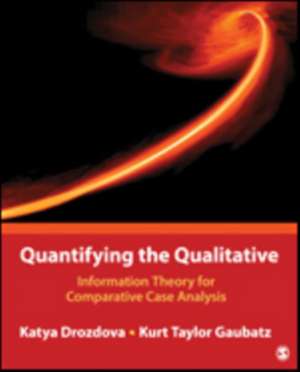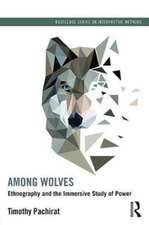Quantifying the Qualitative: Information Theory for Comparative Case Analysis
Autor Ekaterina Drozdova, Kurt Taylor Gaubatzen Limba Engleză Paperback – 8 mar 2016
Preț: 608.64 lei
Preț vechi: 716.05 lei
-15% Nou
Puncte Express: 913
Preț estimativ în valută:
116.47€ • 120.91$ • 97.12£
116.47€ • 120.91$ • 97.12£
Carte tipărită la comandă
Livrare economică 22 martie-05 aprilie
Preluare comenzi: 021 569.72.76
Specificații
ISBN-13: 9781483392479
ISBN-10: 1483392473
Pagini: 192
Dimensiuni: 187 x 232 x 15 mm
Greutate: 0.32 kg
Ediția:1
Editura: SAGE Publications
Colecția Sage Publications, Inc
Locul publicării:Thousand Oaks, United States
ISBN-10: 1483392473
Pagini: 192
Dimensiuni: 187 x 232 x 15 mm
Greutate: 0.32 kg
Ediția:1
Editura: SAGE Publications
Colecția Sage Publications, Inc
Locul publicării:Thousand Oaks, United States
Recenzii
“[Quantifying the Qualitative] gives students the tools they need to enhance systematic case-study analysis.”
“[This text] is a new and fresh approach to learning how to analyze case studies from a qualitative research paradigm that faculty can use and students can wrap their heads around.”
“[This book] just oozes with policy recommendations and future research...a huge contribution.”
“[This text introduces] more contemporary tools to address questions that are important to the world now.”
“[This text] is a new and fresh approach to learning how to analyze case studies from a qualitative research paradigm that faculty can use and students can wrap their heads around.”
“[This book] just oozes with policy recommendations and future research...a huge contribution.”
“[This text introduces] more contemporary tools to address questions that are important to the world now.”
Cuprins
CHAPTER 1: Enhancing Small-n Analysis: Information Theory and the Method of Structured-Focused Comparison
Why Quantify the Qualitative? Enhancing Qualitative Analysis With Information Theory
Who Needs to Quantify the Qualitative?
Information and Action Under Uncertainty
Origins and Motivations
From Cryptography and Communication to Comparative Case Studies
Making Qualitative Analysis of Information Systematic: The Method of Structured-Focused Comparison
Information Theory and Metrics for Qualitative Learning
A Roadmap for Quantifying the Qualitative
Conclusion
CHAPTER 2: The Information Revolution
Information Theory for the Information Age
What’s Under the Hood: A Primer A Primer on Logarithms and Probability for Small-n Analysis
Information Uncertainty Measures
Fundamental Contributions of Information Theory
The Growing Use of Information Metrics
A Note for Practitioners: From Analytics to Action
Conclusion
CHAPTER 3: Case Selection
Research Design and Information Theory
Case Selection Strategies and Challenges
Coding Cases
Case Selection and the Advantages of Information Theoretic Analysis
Conclusion
CHAPTER 4: The Information Method—If You Can Count, You Can Do It
Quantify: Setting up a Truth Table for Comparative Case Analysis
Count: Calculating the Probabilities
Compute: Computing the Uncertainty Measures
Compare: Understanding the Outcomes
Conclusion
CHAPTER 5: Information Metrics at Work—Three Examples
Example 1—Ecology: Information Analysis for Tropical Forest Loss
Example 2—Education: Accounting for Teaching Quality
Example 3— Medicine: Effective Nursing Care
Conclusion
CHAPTER 6: Sensitivity Analysis—Entropy, Inference, and Error
Confidence Intervals and the Information Metric
Analytic Leverage for a Study of Environmental Incentives
The Information Metric and the Problem of Inference
Sensitivity Analysis
Dropped-Case Analysis
Outcome Coding Sensitivity
Conclusion
CHAPTER 7: The QCA Connection
Understanding Qualitative Case Analysis (QCA)
QCA and Causal Complexity
Where QCA and Information Metrics Differ
Examples of Enhancing QCA with Information Metrics
Conclusion
Selected Introductory QCA Resources
QCA Software and Web Resources
CHAPTER 8: Conclusion
Information, Research, and the Digital Era
Reducing Uncertainty and Improving Judgment: Using Information Analysis in the Real World
The Limits and Further Possibilities for Information Analysis
Extensions
Conclusion
APPENDIX A: Using Excel for Information Metrics
Step One: Enter Data
Step Two: Probability Calculations
Step Three: Entropy and Mutual Information Metrics
APPENDIX B: Using R for Information Metrics
Example 1: Deriving Information Metrics from Conditional Probabilities
Example 2: Deriving Information Metrics with the abcd Method
References
Index
Why Quantify the Qualitative? Enhancing Qualitative Analysis With Information Theory
Who Needs to Quantify the Qualitative?
Information and Action Under Uncertainty
Origins and Motivations
From Cryptography and Communication to Comparative Case Studies
Making Qualitative Analysis of Information Systematic: The Method of Structured-Focused Comparison
Information Theory and Metrics for Qualitative Learning
A Roadmap for Quantifying the Qualitative
Conclusion
CHAPTER 2: The Information Revolution
Information Theory for the Information Age
What’s Under the Hood: A Primer A Primer on Logarithms and Probability for Small-n Analysis
Information Uncertainty Measures
Fundamental Contributions of Information Theory
The Growing Use of Information Metrics
A Note for Practitioners: From Analytics to Action
Conclusion
CHAPTER 3: Case Selection
Research Design and Information Theory
Case Selection Strategies and Challenges
Coding Cases
Case Selection and the Advantages of Information Theoretic Analysis
Conclusion
CHAPTER 4: The Information Method—If You Can Count, You Can Do It
Quantify: Setting up a Truth Table for Comparative Case Analysis
Count: Calculating the Probabilities
Compute: Computing the Uncertainty Measures
Compare: Understanding the Outcomes
Conclusion
CHAPTER 5: Information Metrics at Work—Three Examples
Example 1—Ecology: Information Analysis for Tropical Forest Loss
Example 2—Education: Accounting for Teaching Quality
Example 3— Medicine: Effective Nursing Care
Conclusion
CHAPTER 6: Sensitivity Analysis—Entropy, Inference, and Error
Confidence Intervals and the Information Metric
Analytic Leverage for a Study of Environmental Incentives
The Information Metric and the Problem of Inference
Sensitivity Analysis
Dropped-Case Analysis
Outcome Coding Sensitivity
Conclusion
CHAPTER 7: The QCA Connection
Understanding Qualitative Case Analysis (QCA)
QCA and Causal Complexity
Where QCA and Information Metrics Differ
Examples of Enhancing QCA with Information Metrics
Conclusion
Selected Introductory QCA Resources
QCA Software and Web Resources
CHAPTER 8: Conclusion
Information, Research, and the Digital Era
Reducing Uncertainty and Improving Judgment: Using Information Analysis in the Real World
The Limits and Further Possibilities for Information Analysis
Extensions
Conclusion
APPENDIX A: Using Excel for Information Metrics
Step One: Enter Data
Step Two: Probability Calculations
Step Three: Entropy and Mutual Information Metrics
APPENDIX B: Using R for Information Metrics
Example 1: Deriving Information Metrics from Conditional Probabilities
Example 2: Deriving Information Metrics with the abcd Method
References
Index
Notă biografică
Descriere
With clear, step-by-step examples and inclusion of techniques that can be applied to a variety of settings, this book lays out a systematic approach to comparative case analysis based on fundamental insights of information theory



















